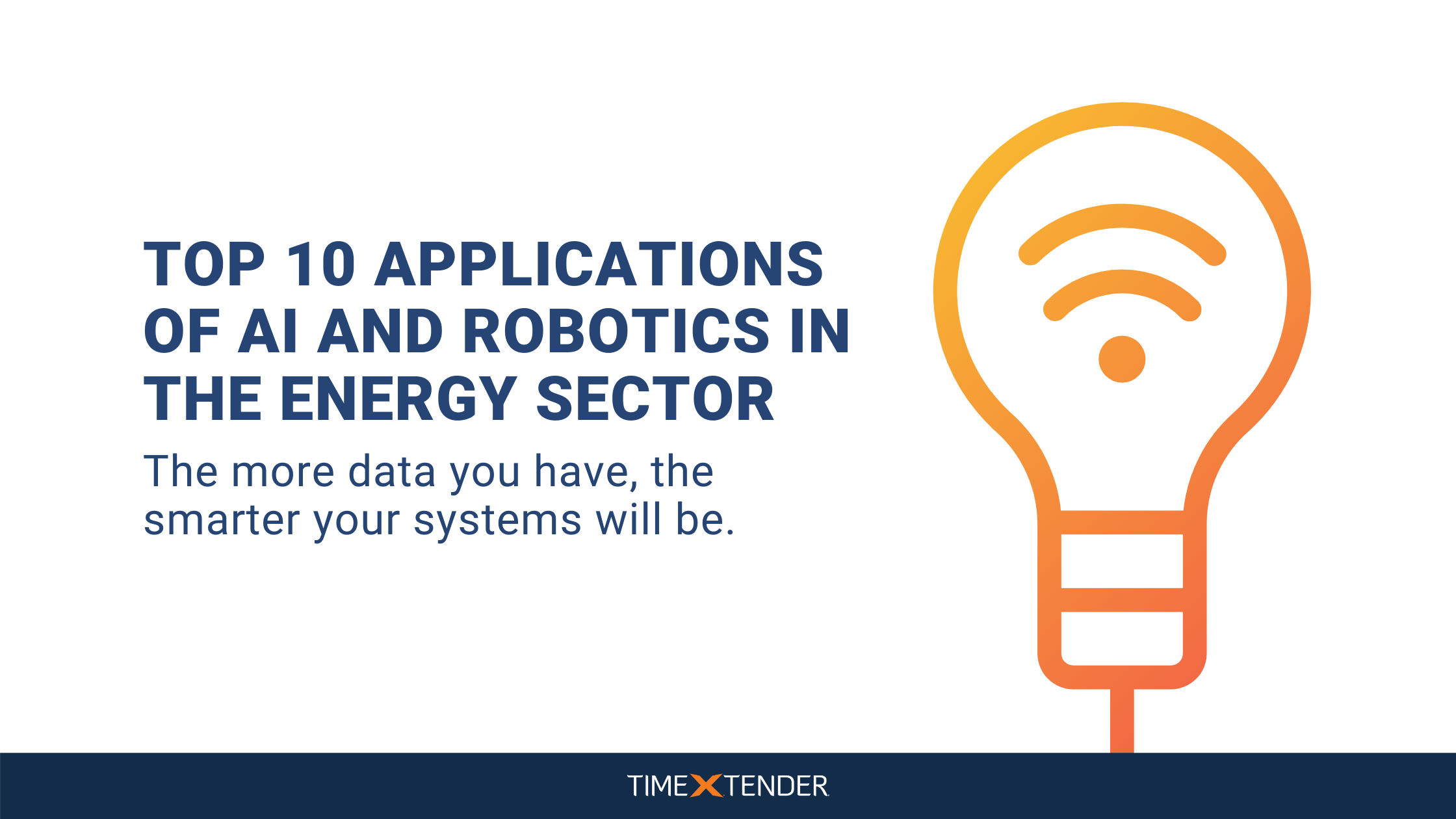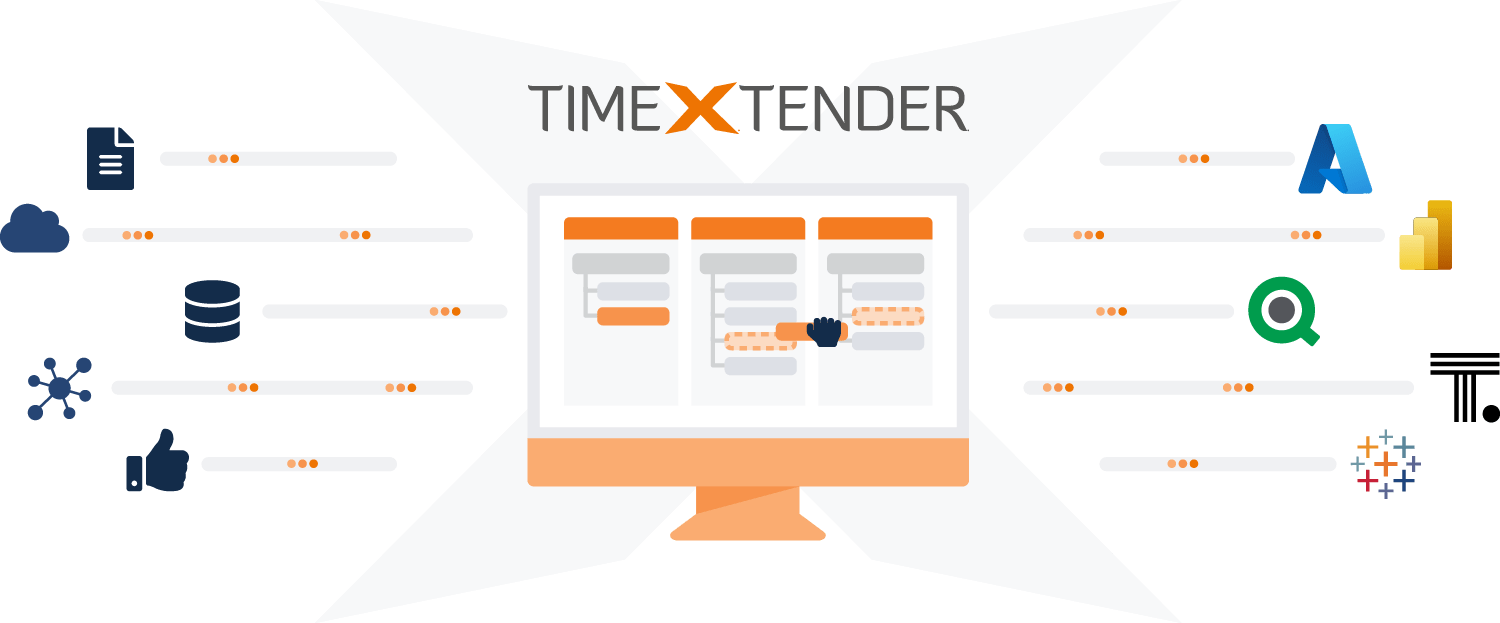6 min read
Top 10 Applications of AI and Robotics in the Energy Sector
Written by: Micah Horner, Product Marketing Manager, TimeXtender - January 10, 2022

The Machine Economy will rapidly transform the energy sector.
Just as “going digital” was a game-changer in the last decade, the next great shift will be about “getting smart”.
To understand the enormity of this shift, here are 3 statistics you need to be aware of:
- AI, machine learning, and robotics will drive 70% of GDP growth over the next decade.
- By 2030, AI will contribute an estimated $15.7 trillion to the global economy, more than the current output of China and India combined.
- 62% of leaders are putting plans in place to succeed in a world filled with connected machines and smart automation – 16% are already investing and performing strongly.
It’s now clear that decision-making AI and machines will be the primary driver of economic growth over the next decade in what's being referred to as the "Machine Economy".
This is especially true in the energy sector, where machines and AI can help energy companies increase energy generation, improve energy efficiency, reduce wastage.
To remain competitive, energy companies need to start data-focused AI and machine learning initiatives immediately. The good news is that the energy sector is in an especially good position to take advantage of these next-generation technologies.
Top 10 applications of AI, machine learning, and robotics in the energy sector
The combination of these new technologies is creating massive, new opportunities for energy companies to improve efficiency, optimize performance, drive innovation, and accelerate growth.
However, rather than trying to simply mimic solutions developed in other industries, it will be important for energy companies to focus on energy-specific solutions, such as:
- Smart Grids
Grids can now be integrated with sensors, data analytics tools, energy storage systems, energy management platforms, and other types of energy technology to become "smart".
By using smart grids, energy companies can collect energy usage data from every single device on the grid, and then use this information to develop energy efficiency projects for their customers. It also allows energy companies to monitor energy flow and energy use in near real-time.
Energy companies can then reduce energy consumption through automated demand response systems which can turn off energy during peak hours, resulting in energy savings for homeowners as well as energy companies.
- Grid Security
The energy grid is a complex system that is vulnerable to cyberattacks. AI and machine learning can be used to improve the security of energy grids by preventing cyberattacks before they happen.
This involves using data analytics to identify patterns in energy data that may be indicative of a cyberattack. Once a cyberattack has been identified, AI and machine learning can be used to respond to the attack.
- Grid Management & Efficiency
AI is used to optimize energy grids by managing energy flows between homes, businesses, storage batteries, renewable energy sources, microgrids, and the power grid itself. This reduces energy waste while increasing consumer engagement with energy consumption.
Renewable energy sources like wind and solar are becoming more popular, but they are intermittent energy sources. This means that energy from these sources is not always available when it is needed.
This presents a problem for the energy grid because the energy has to be managed in real-time as it is being generated. AI and machine learning can help energy companies to predict when renewable energy will be available and manage energy grids accordingly.
Robots are also being used in energy installations and grid maintenance, and for monitoring energy generation and energy consumption. Robots can be used for tasks such as repairing pipelines, wind turbines, and other energy infrastructure. By automating these tasks, energy companies can further improve efficiency and reduce costs.
- Increased Production
AI and machine learning are also being used to improve production in the energy sector.
For example, oil and gas companies are using machine learning algorithms to improve well placement and increase production. By analyzing data collected from seismic surveys and other sources, these companies can make better decisions about where to drill for oil and gas. This will increase energy efficiency and create a simpler, more efficient energy grid that is easier to maintain by energy companies.
- Predictive Analytics
Predictive analytics can be used to predict how energy demand will change in the future. This information can then be used to plan for the future and build the necessary infrastructure to meet future energy needs.
By using predictive analytics, energy companies can also predict when a machine or piece of equipment is likely to fail. This not only helps to prevent unexpected outages, but it also saves money by allowing companies to plan for the replacement of critical and expensive energy assets and avoid unplanned maintenance work.
- Energy Storage
The global energy storage market is set to grow 20x by 2030.
Smart energy storage systems are energy storage technologies that can be integrated into the energy grid to make energy management more efficient.
Energy storage is also being used to create virtual power plants, which allow energy companies to deliver energy when it is needed even if their current energy supply isn't enough. This helps to reduce the need for energy companies to build new power plants.
- Energy Trading
Trading energy is different from trading other commodities because energy has to be delivered immediately. This presents a challenge for energy traders, but it is also an opportunity because energy markets are becoming more liquid.
AI and machine learning can be used to make energy trading more efficient by predicting energy demand and providing traders with real-time information about energy prices. With this information, energy traders can then make more informed decisions about when to buy and sell energy.
Blockchain technology has been used to create power purchase agreements (PPAs), a type of financial contract between energy buyers and energy sellers. Blockchain technology makes these contracts more efficient because it reduces transaction time, costs less to use than traditional PPA platforms, and is built on a highly secure platform.
- Power Theft & Energy Fraud Detection
Theft and fraud of electricity costs the energy and utilities industry as much as $96 billion every year globally, with as much as $6 billion every year in the United States alone.
Power theft is the illegal tapping of energy from the grid. Energy fraud is the intentional misrepresentation of energy data or energy usage. AI and machine learning can automatically detect these anomalies and flag them for energy companies to resolve. This allows energy companies to protect their assets, reduce energy waste, and save money.
- Microgrids
A microgrid is a small energy grid that can operate independently of the traditional energy grid. Microgrid control systems use AI and machine learning to manage energy flow and optimize energy usage.
Microgrids are becoming popular because they can provide energy security during emergencies and can integrate renewables into the energy grid more easily than traditional energy grids.
- Customer Engagement
The energy sector is also starting to use AI and machine learning for customer engagement. By using AI and machine learning energy companies can provide customers with information that is specific to their needs.
This involves using data analytics to understand customer energy usage and then providing customers with information about how they can reduce their energy consumption by changing their usage habits.
Data is a key driver of energy sector growth in the Machine Economy
The smarter the machines get, the more they can do for us, especially when they start engaging with each other autonomously to carry out production and distribution, without the need for human intervention.
However, none of this is possible without data.
Digital-first energy and utilities companies won in the last decade because they had fast access to reliable data. Now, these companies have a head start, as data is the key to unlocking the power of AI and machine learning.
The more data you have, the smarter your systems will be.
Data teams face daunting challenges in the Machine Economy
Data volumes are exploding, but expectations for how fast data should be curated, prepared, and delivered for analysis and AI/machine learning haven’t changed.
Many data teams are struggling to keep up.
Traditionally, data management has relied on a highly-complex stack of tools, a growing list of data sources and systems, and months spent hand-coding each piece together to form fragile data “pipelines”.
Then came data management “platforms” to the rescue. They promised to reduce complexity by combining everything into a single, unified, end-to-end solution.
In reality, they impose strict controls and lock you into a proprietary ecosystem that won’t allow you to truly own, store, or move your own data.
It’s clear that the old ways of doing data management simply cannot meet the needs of modern organizations.
Data teams are in desperate need of a faster, smarter, more flexible way to ingest and prepare their corporate data for analysis and AI/machine learning.
Goodbye, data management. Hello, data empowerment.
TimeXtender is a data estate builder that empowers you to implement a modern data estate 10x faster with a simple, drag-and-drop user interface for ingesting and preparing data for analysis.
TimeXtender seamlessly overlays your data infrastructure, connects to any data source, and provides all the powerful data preparation capabilities you need in a unified, secure, future-proof solution.
We do this for one simple reason: because time matters.
Data teams at top-performing organizations such as Pandora, Komatsu, Colliers, the Puerto Rican Government, and the City of Lansing Michigan are already taking this new approach by using TimeXtender, the low-code data estate builder.
How TimeXtender empowers everyone on your team:
- Business leaders can get fast access to reliable data, while reducing build costs by 70%, and maintenance costs by 80%.
- Data professionals can be free from tedious, repetitive tasks, and have time to focus on more fulfilling, high-impact analytics projects.
- Business users can start creating their own data products – no more bottlenecks.
With this new approach, a better and stronger energy sector emerges.
This is what winning looks like in the Machine Economy.
Learn How to Become Data Empowered with TimeXtender
Book a demo to learn how we can help you build a modern data estate 10x faster, become data empowered, and win in the Machine Economy.



